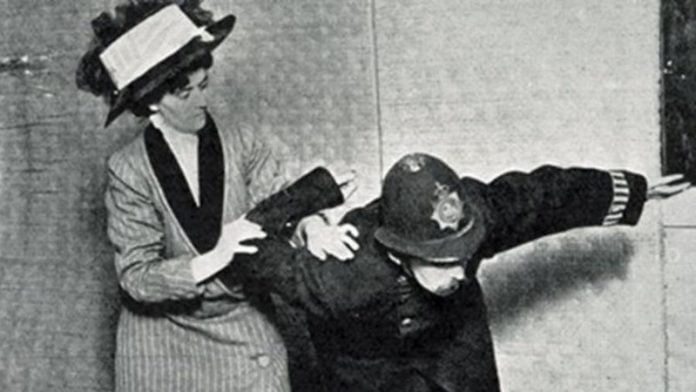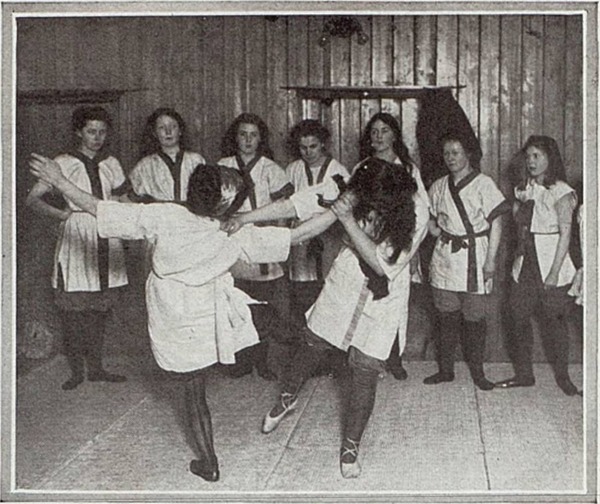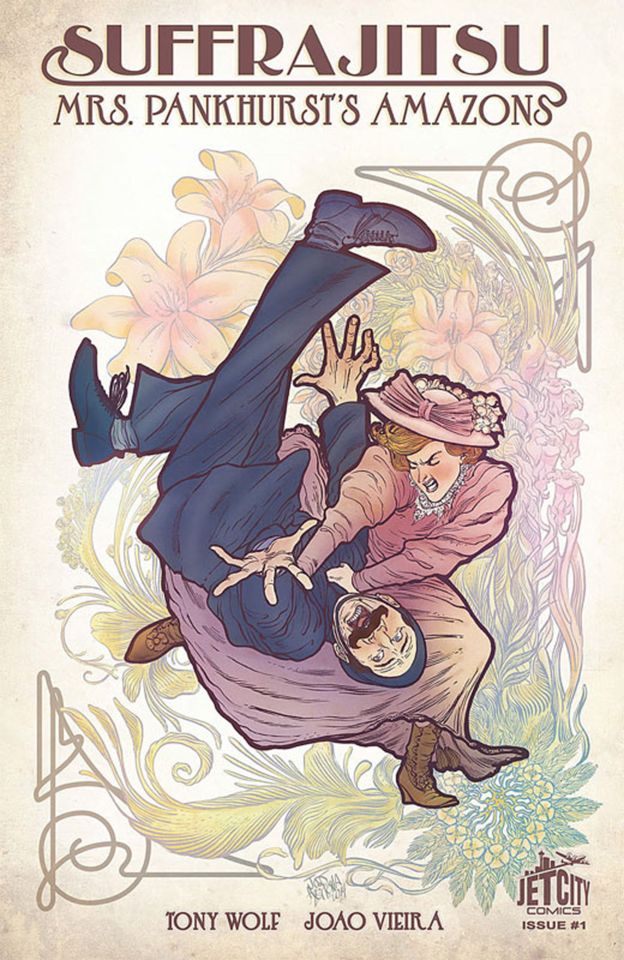
It is March the 8th everyone, and that means International Women’s Day! Here at BJJ world, we’d like to wish all the ladies of the world a happy Women’s day and to always keep fighting! The fighting spirit of the finer half is beyond question, as everyone who trains grappling knows. In honor of all the ladies who fought tooth and nail for their rights, today we’ll focus on a part of Jiu-Jitsu history that’s not overly famous. Do you know who the suffragettes were? How about what Suffragette Jiu-Jitsu is? Time to honor the ladies of the past and present and see how Jiu-Jitsu helped them achieve a major goal!
We live in a society today that preaches equality at every turn. While there are certain aspects of modern-day political correctness that go beyond the realm of the reasons, one thing is beyond a doubt, women and men are absolutely equal. As such, they should have equal rights and opportunities in both life and sports. Brazillian Jiu-Jitsu is a sport that welcomes ladies wholeheartedly with some of the sport’s main ambassadors and world champions being members of the finer half. Back in the days when women had a necessity to know self-defense, suffragette Jiu-Jitsu was the answer, at least when it comes to 1900’s Scotland.
The Suffragettes
Who exactly were the suffragettes? Put simply they were a militant women’s organization in the early 20th Century, based in Britain. Their main goal was to deliver to women nationwide, and subsequently, worldwide the right to vote in public elections. This was known as women’s suffrage.
The leader was Emmeline Pankhurst, a woman who founded the Women’s Social And Political Union (WSPU) in 1903. Pankhurst battled for women’s rights to work and vote, with the motto of the WAPU being “deeds, not words”. The term suffragette came courtesy of a Daily Mail reporter. Namely, the reporter coined the term from suffragist trying to belittle women. Little could he know how it would backfire.

The militant tactics did manage to attract a lot of attention to the fact women had no right to vote. So much attention, in fact, that they fast became the focus of hecklers, police, and even politicians. This, in turn, led to an increase in violence over them, and the need for self-defense was born. The solution to it was suffragette Jiu-Jitsu.
Suffragette Jiu-Jitsu
Suffragette Jiu-Jitsu came about thanks to the efforts of one woman in particular. Edith Garrud was the woman who introduced the suffragettes to Jiu-Jitsu, and ultimately got them literally ready for the fight. Back in the days of direct suffragette action, it was common for the women to be thrown around, beaten and two suffragettes even died. There were also instances of force-feeding them with rubber tubes during a hunger strike. All of this, and more led to the ladies looking into ways to defend themselves and take the fight to the men.

As a petite woman, Edith’s martial art of choice was Japanese Jiu-Jitsu. Since it was all about leverage and skill rather than strength, it was perfect. Initially, it was about self-defense, mostly from hackers that tormented the women during rallies. But it soon turned to much more than that, after clashes with the police became more frequent. The suffragettes got so good at it, that the press soon noticed and published a series of articles on suffragette Jiu-Jitsu” or “suffrajitsu”.
“The Bodyguard”

Of course, much of their fighting experience was based on suffragette Jiu-Jitsu. “The Bodyguard” had around 30 women that acted as Pankhurst’s personal guard. During several instances, they protected Pankhurst by a combination of fighting skills and cunning. There’s one example where the police thought they had Emmeline, after a huge speech, just to find out they got a decoy instead.
In 1914, in Glasgow, Scotland, the infamous “Battle Of Glasgow” took place at St. Andrew’s Hall. Pankhurst held a speech and “The Bodyguard” kept watch. Not long after Emmeline emerged on stage, the police went after her. Suffragettes jumped into action, and a several minute clash happened on stage. The fight involved 30 suffragettes and double the number of policemen. Despite their training and the clubs they carried, the suffragettes lost the brawl.
Despite the loss, Garrud and her suffragettes kept grappling and fighting for the cause, until a global problem in the shape of World War 1 turned everyone’s attention.
Conclusion
Suffragette Jiu-JItsu is just another great example of the effectiveness of Jiu-Jitsu throughout history. As we all know, the right to vote is now undisputed for members of both sexes. Still, every era brings about new challenges, both for men and women. Self-defense is as much a necessity now, as it was during Edwardian Scotland. Today, Brazilan Jiu-JItsu offers both self-defense, and self-confidence, for all modern-day suffragettes and ladies in general that like to be as strong as Pankhurst and Garrud!


![Darce Choke Encyclopedia – Origins, Mechanics and Variations [2025] BJJ, choke, Brabo, BJJ Darce Choke, D'arce Choke, Darce BJJ Choke](https://bjj-world.com/wp-content/uploads/2017/11/JungPoirierLeeYahoo-218x150.jpg)









![X-Guard Trickery Kyle Sleeman DVD Review [2025] X-Guard Trickery Kyle Sleeman DVD Review](https://bjj-world.com/wp-content/uploads/2025/03/x-guard-trickery-kyle-sleeman-dvd-review-218x150.png)
![Countering with Crab Ride Anthony Budion DVD Review [2025] Countering with Crab Ride Anthony Budion DVD Review](https://bjj-world.com/wp-content/uploads/2025/03/countering-with-crab-ride-anthony-budion-dvd-review-218x150.png)
![Closet Closed Guard Craig Jones DVD Review [2025] Closet Closed Guard Craig Jones DVD Review](https://bjj-world.com/wp-content/uploads/2025/03/closet-closed-guard-craig-jones-dvd-review-218x150.png)
![Xanadu Back Takes Levi Jones-Leary DVD Review [2025] Xanadu Back Takes Levi Jones-Leary DVD Review](https://bjj-world.com/wp-content/uploads/2025/03/xanadu-back-takes-levi-jones-leary-dvd-review-218x150.png)

![No-Gi Grapplers Guide To Front Headlock Joel Bane DVD Review [2025] No-Gi Grapplers Guide To Front Headlock Joel Bane DVD Review](https://bjj-world.com/wp-content/uploads/2025/03/no-gi-front-headlock-joel-bane-dvd-review-218x150.png)


![Dynamic De La Riva Guard Otavio Sousa DVD Review [2025] Dynamic De La Riva Guard Otavio Sousa DVD Review](https://bjj-world.com/wp-content/uploads/2025/02/dynamic-de-la-riva-guard-otavio-sousa-dvd-review-100x70.png)





![Effectively Passing The Guard Luke Griffith DVD Review [2025] Effectively Passing The Guard Luke Griffith DVD Review](https://bjj-world.com/wp-content/uploads/2025/01/passing-the-guard-luke-griffith-dvd-review-100x70.png)

![Front Head Lock Kaynan Duarte DVD Review [2025] Front Head Lock Kaynan Duarte DVD Review](https://bjj-world.com/wp-content/uploads/2025/02/front-head-lock-kaynan-duarte-dvd-review-100x70.png)
![Knee Lever John Wayne Sweep Adam Wardzinski DVD Review [2024] Knee Lever John Wayne Sweep Adam Wardzinski DVD Review](https://bjj-world.com/wp-content/uploads/2024/12/john-wayne-sweep-adam-wardzinski-dvd-review-100x70.png)
![Foot Sweep the World Dainis Nguyen-Huu DVD Review [2024] Foot Sweep the World Dainis Nguyen-Huu DVD Review](https://bjj-world.com/wp-content/uploads/2024/11/foot-sweep-the-world-dainis-nguyen-huu-dvd-review-100x70.png)


![Higher Tripod Passing Craig Jones DVD Review [2025] Higher Tripod Passing Craig Jones DVD Review](https://bjj-world.com/wp-content/uploads/2025/02/higher-tripod-passing-craig-jones-dvd-review-100x70.png)
![Assassin Choke Baret Yoshida DVD Review [2024] Assassin Choke Baret Yoshida DVD Review](https://bjj-world.com/wp-content/uploads/2024/10/assassin-choke-baret-yoshida-dvd-review-100x70.png)

![Zen Guide To Submission Grappling Margot Ciccarelli DVD Review [2025] Zen Guide To Submission Grappling Margot Ciccarelli DVD Review](https://bjj-world.com/wp-content/uploads/2025/02/submission-grappling-margot-ciccarelli-dvd-preview-100x70.png)
![Two Sides One Game Sweep and Pass Marcos Tinoco DVD Review [2024] Two Sides One Game Sweep and Pass Marcos Tinoco DVD Review](https://bjj-world.com/wp-content/uploads/2024/11/sweep-and-pass-marcos-tinoco-dvd-review-100x70.png)

![Crossing and Spinning Steps To Attack Israel Hernandez DVD Review [2024] Crossing and Spinning Steps To Attack Israel Hernandez DVD Review](https://bjj-world.com/wp-content/uploads/2024/09/spinning-steps-to-attack-israel-hernandez-dvd-review-100x70.png)
![Roger Gracie Guard Passing System DVD Review [2025] Roger Gracie Guard Passing System DVD Review](https://bjj-world.com/wp-content/uploads/2025/02/roger-gracie-guard-passing-system-dvd-review-100x70.png)




![Kill The Underhook Dima Murovanni DVD Review [2024] Kill The Underhook Dima Murovanni DVD Review](https://bjj-world.com/wp-content/uploads/2024/10/kill-the-underhook-dima-murovanni-dvd-review-100x70.png)
![Dynamic Headquarters Passing Jason Rau DVD Review [2024] Dynamic Headquarters Passing Jason Rau DVD Review](https://bjj-world.com/wp-content/uploads/2024/10/dynamic-headquarters-passing-jason-rau-dvd-review-100x70.png)